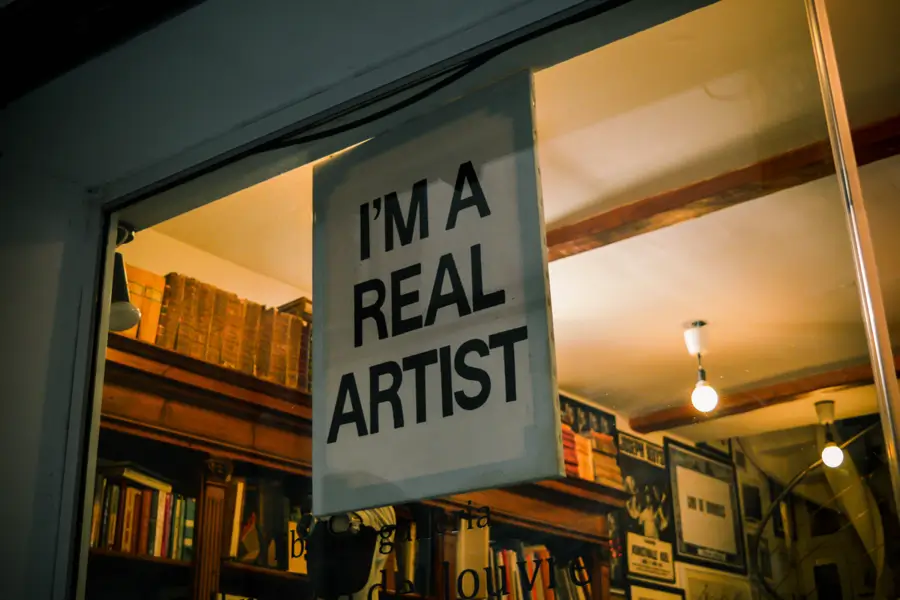
BUSINESS BASICS

You likely agree with the practical sentiment that, while financial success isn’t the only measure —or even close to the best measure—of success, you do need to pay the rent and buy groceries. These mundane issues have been a thorn in the side of many artists brimming with passion, vision, and the energy to share their perspectives with the world.
While many artists take on jobs that have nothing to do with their artistic passions, you may not want to take that path. If you have a singular vision that revolves around your art, a regular day job may prove to be an exercise in futility and frustration for you and any potential employer. Meanwhile, your business is languishing in non-existence, which is no good.
The truth is that there are more ways than ever to earn a living doing what you love. You just have to devise a strategy, along with your heart and your passion, and you soon find the opportunities awaiting you.
Now that you know that you can earn a living doing what you love, it may help you to take a look at some tips to help you get things rolling.
Before you even start planning your art career, spend time reflecting on what it is you ultimately want for and from your business. Take this time to ask yourself what your dream job looks like, recommends Patrick Allan at Lifehacker. Also, honestly assess your financial situation, as well as what comforts and pleasures you are willing to sacrifice while working to achieve your dreams. A clear vision of what you might expect and can accept will help you kick off your new career with purpose, verve, reality, and confidence.
At this point, it is also important that you prepare yourself for the fact that the path toward your goal is not likely to be linear. Not at all. It may look more like you’re inside of a crazy straw, but knowing that in advance makes it seem less scary when you’re sliding around inside. Looking back on this strategy tip, you can remind yourself that you are still on your way. It will just take a little longer. There is still joy to experience along the way, as well as tough-but-necessary lessons and disappointments. Even more importantly, you may find that your goals may change along the way. Whether due to the necessity of circumstances, or an unexpected shift of your passion, allow for changes in plans.
Becoming a part of an artists’ community to support your passion is essential. Even if you are more of an introvert—or even mildly misanthropic—you are going to need to find an artists’ community where you can gather ideas, and share information, and yes, you can even network and find new opportunities you might not find on your own. You might learn about relevant grants, residencies, teaching and guest artist programs at local universities, private commissions, and new online opportunities when you branch out and put some trust in your fellow artists.
Working to build your own business is often isolating—especially if your friends and family are not completely on board—so becoming part of a community can help keep you from feeling lonely, which can erode your confidence. And you will need your confidence every step of the way.
Here are a few places where you can find your ideal professional artist community:
Online: The internet offers a wealth of support for artists with page after page of art communities ready to make your acquaintance. Explore forums, blogs, and social media pages to get started.
Local Coffee Shops: As clichéd as it may seem, coffee shops are still often a bastion of community support for artists and writers. Visit some locally-owned shops that display local artists’ work. Even if you don’t see any local exhibits, check to see if they have a bulletin board announcing clubs and communities. If nothing else—and if you like the atmosphere of the coffee shop—ask the barista or the manager if you can post a notice to start a community of your own.
Community Centers: Your local Department of Parks and Recreation may have a brochure brimming with support for artists.
According to The Partnership Movement, business owners consider creativity a key asset, so your skills are a natural fit in today’s market. Your ability to think outside the corporate box can become your calling card, making you invaluable in your business community. Below are just a few of the possible industries and businesses that can use your talent:
Advertising Agencies: You never know when a local advertising agency needs a fresh perspective when creating a new print ad.
Playhouses and Professional Theatres: Your local college theatre company or your town’s community playhouse may need help designing and creating an elaborate new set.
Marketing Firms: If a local marketing firm has a new international client with a multifaceted campaign, they may need extra hands on deck to help achieve the client’s vision. Your fresh perspective and artistic skills may be just what they need.
Schools, Colleges, and Recreation Centers: You may explore opportunities in substitute or adjunct teaching opportunities with schools and colleges. Another possible venue for teaching is your local recreation center where art classes are often offered.
An additional benefit to exploring your local community’s artistic needs is that, by stepping out of your comfort zone, you are building strong connections in the business community. These relationships can easily translate into new opportunities thanks to good word-of-mouth about your artistic talent, practical skills, and strong work ethic.
The more layers and skills you add to your artistic talent, the more marketable you will become.
Keep Learning: Register for graphic design, CAD, marketing, tattooing classes, or online coding tutorials.
Teach Others: Earn teaching certifications so you can fill in for absent teachers or take on your class.
Perform Mock Meetings: Work with friends and fellow artists to sharpen your interviewing skills. This skill will come in handy when you meet with gallery owners and other prospective decision-makers.
Dip Your Toes Into Creative Ponds: Avoid limiting your project potential by accepting projects outside of your comfort zone. If someone needs help drawing part of their graphic novel or comic book—and you’ve never done this kind of work—be honest, but also be willing to help out and do your best. Anything that adds to your skills, portfolio, and network helps you stay sharp as you build your professional artist’s reputation.
Build Your Brand: Take marketing classes and talk to your artists’ community to help generate new ways to build your brand. Start by creating and fostering a strong social media presence on platforms like Instagram, Twitter, Pinterest, Facebook, and LinkedIn. Another brand-building strategy is to start a blog—or a vlog if that is more your style—filled with thoughtful, helpful, and sincere content for your readers.
Submit Your Work for Art Fair Entries: Gaining entry to art fairs will give you the chance to work on themed projects and place your work among that of your peers, adding to your overall exposure in the arts community.
Stay creative on this point, and keep exploring your interests and opportunities so you can add to your list of skills and education.
Here’s where the fun begins. With the continuing evolution of the internet, along with an increasing number of business owners choosing to hire freelancers and independent contractors for long-term projects, you may be amazed at the abundance of possible revenue streams you will discover.
Commissions: Explore opportunities to work for private businesses or local government offices to create art pieces. Perhaps your county fair needs help with specific exhibits, or a local business owner would like a family portrait or a new art piece for their company’s lobby.
Commercial Work: This type of revenue stream can become consistent with the right company. You might design logos or T-Shirt designs for a clothing company or a new menu for a local restaurant in this arena.
Online Sales: Your computer savvy, blogging abilities, and content development can help you sell your own work online.
Apply for Grants: Gain additional exposure while also receiving funding slated for artists by applying for grants for fine artists, curators, researchers and more.
Additional revenue streams you can explore include seeking sponsorships from art supply companies, licensing your art that can result in one-time fees or royalties paid over time, applying for grants, and exhibiting your work at galleries.
You always want to have an updated portfolio that offers an at-a-glance view of your work. While your art blog certainly serves as a comprehensive exhibit of your work, always maintain your hard copy portfolio that you can take with you to meetings with new clients.
Stay Patient, Focused, and Ready for Success: Remember that this project is about your future and that patience is critical. By creating a solid strategy and keeping with it, you can do what you love and get paid.

The Art Career Project is a trusted resource for emerging and professional artists.